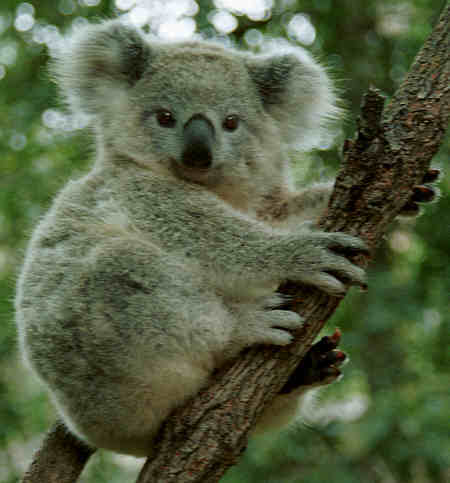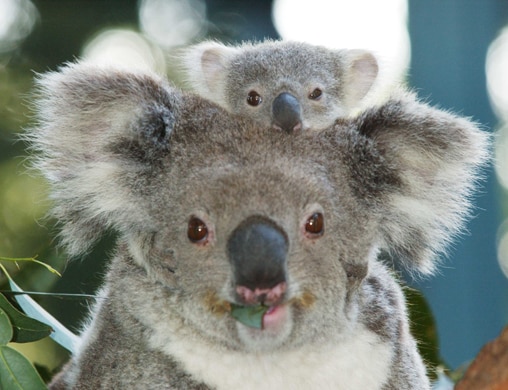The koala is the Australian jewel. It has very furry, ash colored hair, a rubbery black nose, sharp claws, fuzzy ears, and a grizzly personality. If you kill a koala, you’ll make a million off their fur! They would sell the fur to coat companies and make coats out of koala fur. Well, sadly enough, too many people are making millions on koalas. That’s why they’re endangered species.
Habitat
The koala is distributed along the eastern coastal semi-tropical forests of Australia, ranging from north Queensland, New South Wales, Victoria, and a small area in the south of Australia.
Breeding
The male koala and the female koala have two very different mating calls. When humans reach their sexual maturity at around the age of 14 or 15, koalas reach their sexual maturity at the age of two.
The female produces one baby every other year. The koala almost never produces twins. In the female’s pouch, there are two nipples. The female koala gives birth after a 20-35 day gestation period. When the joey (baby koala) is born, it is no longer than 2 cm and weighs no more than a 1/2 gram.
The joey stays in its mother’s pouch for 5-7 months. The term ³joey² is used when you are talking about a baby marsupial. The mother gives ³pap² to the joey, a liquid from the caecum (which is similar to the human organ, appendix.) This is thought to give the joey the ability to eat only eucalyptus leaves.
When the joey emerges from the pouch, it clings to its mother for another seven months. The joey stays with its mother for other three or four years, until it is fully grown.
Diet
Koalas eat eucalyptus and don’t drink water. In the aboriginal language, ³koala² means ³no drink water.² But, the koala does drink water, only when it is ill. Out of the 350 species of eucalyptus, the koala can only eat 20, will only eat 5, and only prefers to eat a certain one.
Population and Extinction
Since the koala population has dropped since 50% since the turn of the century, the Australian government passed a law banning anything harmful to the koalas. At first, in the 1920’s they were killed for their fur.
Then, somehow, a high percentage of them became infected with a very contagious disease, chlamydia psittaci. Chlamydia psittaci causes blindness, pneumonia, and for females, sterilization. It has slowed down a lot since it was first introduced to the koala population, but the virus is still going around (chylamydia psittaci is an endangered virus.)
The koala population is also still falling due to destroyed habitats. The developers are coming into koala habitat and cutting down eucalyptus, selling it and building homes. By the 2030’s, the koalas will have no place to live.
Now, sadly, in Sydney, koalas must cross the street to get to another eucalyptus tree. They have to go to another eucalyptus tree every once and a while because that tree is the same tree from the same forest. A lot of koalas are now becoming roadkill.
General Information
The koala is a one of a kind animal. It is the only one of its kind. There are two sub-species of koala though, in which there is the tiniest difference. The southern one has a darker colored fur than the northern because it is colder in the south. The koala has only one relative, the wombat. Koalas and wombats share a common ancestor from some 25 million years ago on the landmass Laurasia (an ancient landmass that separated to make South America, Africa, and Australia.)
Most people think that the koala is related to bears, that is not true, the koala is an aboreal (tree dwelling) bear. Most people also think that the koala is not harmful, that’s wrong. The koala is more like a grizzly bear than a teddy bear. The koala is dangerous because of its extremely sharp claws. Its scientific name is Phascolarctos (pouched bear) cinerus (ash-colored.)
An adult four year old koala eats 1.3 kg. (3 lb.) of eucalyptus per day. It also weighs 13.6 kg. (30 lb.) and is 60-85 cm. (21-33 in.) The koala sleeps a lot. The koala is also nocturnal, that’s why the koala exhibit at the zoo is always boring. The eucalyptus that the koala eats is very important to them because if they change to a different forest, it could be fatal because they can usually only eat one species of eucalyptus.
Bibliography
Gaynor, Beth. Columbus Zoo: The Animals: Koala, http://ourworld.compuserve.com/homepages/BGa ynor/docent.htm (Columbus: compuserve.com) Encyclopædia Britannica, 1992 ed., 6:922, 23:357, 8:642-3. (Chicago: Encyclopædia Britannica, Inc.) S. Bahr, Lauren, e.d. & Johnston, Bernard, e.i.c. Collier’s Encyclopædia, 1992 ed., 3:253, 14:129. (New York: Macmillan Educational Company) Encyclopædia Americana, 1996 ed., 16:526, 18:371. (Danbury: Grolier, Inc.) H. Harris, William, e.d. & S. Levey, Judith, e.d. The New Columbia Encyclopædia, 1975 ed., p. 1491 (New York: Columbia University Press) Bergh, John. Austrailian Koala Hospital Assosiation, Inc.: Koala Facts Sheet, http://onthenet.com.au/~jbergh/koala2.htm (Sydney: onthenet.com) Bergh, John. Austrailian Koala Hospital Assosiation, Inc.: Koala Facts Sheet, http://onthenet.com.au/~jbergh/koala4.htm (Sydney: onthenet.com) Bergh, John. Austrailian Koala Hospital Assosiation, Inc.: Koala Facts Sheet, http://onthenet.com.au/~jbergh/koala1.htm (Sydney: onthenet.com) World Book Encyclopædia, 1996 ed., 11:361 (Chicago: World Book, Inc.) Payne, Oliver. ³Koala‹ Out on a Limb,² National Geographic Magazine, April, 1995 (Washington, D.C.: National Geographic Society Press) Academic American Encyclopædia, 1994 ed., 12:103. (Danbury: Grolier, Inc.)



Thanks